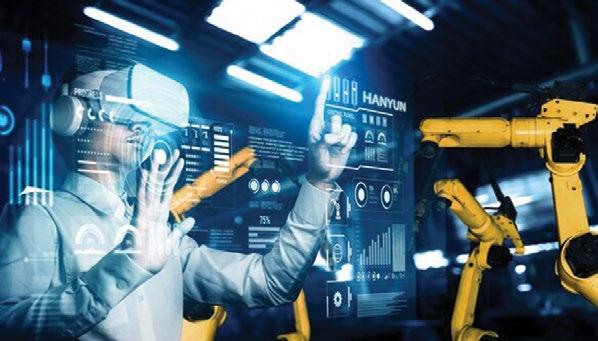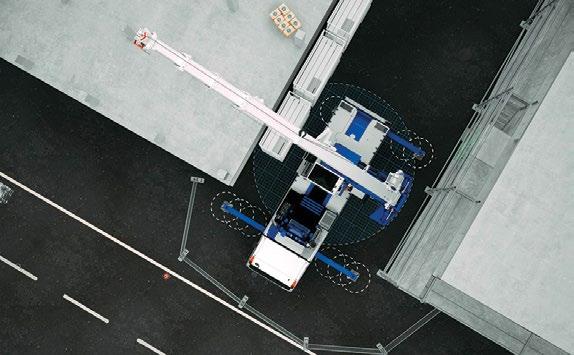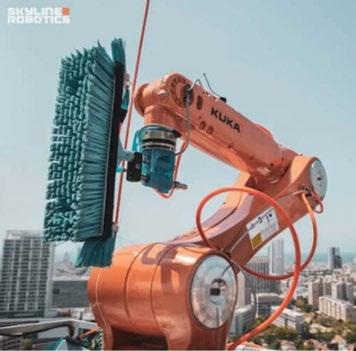
14 minute read
AI and digitalisation…
AI and digitalisation…
The last time C&A covered ‘technology and software’ in 2021, the hot topics were BIM - Building Information Modelling - and VR - Virtual Reality. How things have moved on with AI and digitalisation now being the buzz words which seem to be mentioned in every new model introduction or updates as well as in product support services. We take a look at some of the very latest developments…
The aim of all this new technology is allow us to carry out everyday tasks quicker, more efficiently and more safely. It can also allow us to make better informed decisions through having more detailed information.

Today the focus is on digitalisation - the integration of digital technologies into business operations to optimise processes, enhance customer experiences and drive innovationadvanced machine operation as well as innovative drive and material technologies with major manufacturers investing billions in developing and integrating the new technologies.

At Bauma, companies such as Liebherr demonstrated practical applications using the latest technology. This included operating a large mining machine hundreds of kilometres away via remote control or using a web application for the autonomous operation of a machine under real conditions. AI - Artificial Intelligence - is now being used as chatbots in the customer service department or to identify people in danger by being in the working area of a machine.
Many of the major construction equipment companies are partnering with or even investing in, one or more specialist tech companies to speed up development. For example, Chinese manufacturer XCMG’s industrial internet division, XCMG Hanyun, has formed a partnership with DeepSeek - a Chinese based AI development company - to develop AI applications to build into its aerial lifts and construction equipment and its manufacturing operations.


The collaboration focuses on two main areas: intelligent connected vehicles and smart manufacturing. The vehicle technology will incorporate data analytics, intelligent scheduling, predictive maintenance and fault pattern analysis, while the manufacturing applications will target production optimisation and supply chain forecasting. The system processes more than 300 operational parameters from each machine, including location data, working conditions, hydraulic pressures and vibration patterns. XCMG says the new AI platform has reduced predictive model development time from two weeks to 20 minutes, significantly improving deployment efficiency.
AI pedestrian recognition
Several manufacturers have already developed ‘human’ recognition systems using AI to detect pedestrians within a pre-set proximity of the machine. One of the first to launch a system was JCB with its Intellisense. The system uses four cameras - three giving 270 degrees AI camera coverage around the sides and rear of the machine and a standard forward facing camera. When a person is detected there are audible and visual warnings inside the cab for the operator and externally to warn anyone in the immediate vicinity. Full integration with JCB’s LiveLink telematics system also provides an alert button that allows the operator to record a 10 second data segment that is automatically stored. The system will initially be available on a couple of its mid-range fixed frame telehandlers.

Another telehandler manufacturer that has launched a similar system is Dieci with its Hi-Vision system on its Pegasus Elite 360 degree models. Dieci’s system consists of six high resolution cameras providing 360 degree visibility up to 30 metres, three lidar sensors for 3D dimensional mapping, and a control unit that is said to process data eight times faster than standard units. The system will be installed across three models. The system displays real time warnings for person detection around the machine, obstacle identification in outrigger zones, ground condition monitoring and attachment change assistance.
Dieci said: “The Hi-Vision System is a valuable tool for increasing productivity, maintaining full control of the processes and ensuring high safety standards on construction sites.”

Leica XSight360
Leica Geosystems has just launched the Leica Xsight360. Like the other systems it detects people or objects in the immediate vicinity and alerts the operator. Video and alert data is also transmitted to the cloud where agentic AI generates reports and recommendations for safety professionals.
Agentic AI is a system composed of ‘agents’ that can operate autonomously to achieve specific goals, often with limited human supervision. It is characterised by its ability to make decisions, take actions and adapt to changing environments in pursuit of those goals. This contrasts with traditional AI which often requires more direct human guidance and control.
The Xsight360’s visual AI models are specifically trained for construction operations and continuously improve performance through machine learning. The Leica CRS360 AI processor runs AI pioneer Presien’s most advanced model to date - refined over 700,000 hours of real world job site operation - to deliver low-latency operator alerts with minimal false alarms.
The system supports up to six cameras, providing 360 degree coverage on any machine, to detect people, vehicles and cones etc… to reduce the likelihood of accidents.
The data it generates provides valuable insights that can be used by health & safety managers to identify issues and opportunities for improvement. The vast amount of video input is interpreted by AI and transformed into safety indexes, dashboards, and reports within minutes. Users can quickly compare video footage to international, national, or site-specific safety policies, gaining an immediate overview of possible regulation violations, so they can make better and faster decisions. The product will initially be available in the UK, with plans to expand into other regions in the near future.

Liebherr innovation
Liebherr has always aimed to stay ahead of the game when it comes to new technology and innovations. At Bauma its InnovationLab showed off its future-oriented technologies and concepts with a focus on digitalisation, advanced machine operation, as well as new driveline and material technology.
With fully autonomous machine operation now possible Liebherr unveiled two components within the autonomous system. The first allowed visitors - through a 3D photo booth - to see themselves through the ‘eyes’ of a machine showing images of how the machine perceives it surroundings.
The second - the Autonomous Job Planner web application - allows intuitive planning of autonomous work assignments. The system was demonstrated with two autonomous wheel loaders working on site without any involvement from an operator. The autonomous technology was installed on standard production wheel loaders, however the application will potentially be compatible with other autonomous products in the near future.


Crane finder
Liebherr Ehingen is already using digitalisation technology in a number of crane related products, including lift planning, operator training and maintenance. Its Crane Finder helps select the best crane for a lift, by entering a few details such as the load, required height and radius, the Crane Finder outputs a whole range of possible cranes for the job. The application favours the smallest possible crane with the lowest configuration and naturally gives priority cranes in a company’s fleet, assuming they have entered the fleet into its via MyLiebherr programme.
A new function added to the system makes it possible to match the crane selection even more precisely to the job. For example, if the crane operator knows that access to the site is restricted, he can choose a reduced outrigger setup. Another new feature is the freezing of selections, so, for example, the reduced outrigger setup is retained even if other parameters are changed. There is also an update to the crane portfolio which now includes Liebherr’s MK mobile self-erecting tower cranes. The Crane Finder is available on computer, tablet or mobile phone and is free and available for all Liebherr mobile and crawler cranes.

Expanded crane planner
Crane Planner 2.0 can now simulate every job to scale and in 3D on a computer. Users have also recently been able to import 3D construction site models in DWG and IFC formats and thus adapt the lifting operation even more precisely to the real conditions on the site. The crane portfolio has also been expanded with planning in 3D possible with a telescopic crawler - the LTR 1150. Users can choose from a total of 44 machines - 15 LTM cranes, two LTC cranes, one LTR, one LRT and 26 cranes from Liebherr Nenzing.

Tadano digital Services
Tadano is stepping up its use of digital tools to improve its services while optimising fleet management, maintenance and operational efficiency. Apps include Tadano Pro - a central platform for accessing comprehensive information on Tadano cranes including data sheets, brochures and presentations. The Evolt app - for owners of Tadano electric Rough Terrain cranes - provides real time data on battery status, operating history and travel routes in order to help make the best possible use of the crane’s performance while supporting efficient planning. The Tadano e-Service platform simplifies access to a wide range of the manufacturer’s services under a single account. Customers can use tools such as LiftAPI for performance calculations, Hello-Net for telematics and the myTadano portal. The platform also offers seamless employee account management, allowing companies to customise access to specific services for their teams.

Tadano’s latest product is the AI-driven tool ‘Hey Tadano’ which it claims will redefine customer interaction. As with Amazon’s Alexa, the Hey Tadano app responds to questions about all manner of Tadano products and services which it claims offers a level of accessibility and efficiency that sets a new industry standard.

Tadano surround view
Tadano’s Surround View - available for the AC 4.080-1, AC 7.450-1 and AC 2.040-1 All Terrain cranes - provides 360 degree vision around a crane making it easier for the operator to set up on site. The system uses up to six cameras to display the possible outreach of the outriggers, as well as the tail swing in real time. Surround View also gives the operator a complete overview of what’s around the crane when making left or right turns and uncovers blind spots that may conceal pedestrians, cyclists or other obstacles. It is automatically activated when the turn indicator is operated. The system has a video feed shown on a separate display in the carrier cab and can be used as a driver aid while on the road. It also indicates the outrigger positions and installed counterweight.
Manitowoc connect
As well as making improvements to its Grove and Potain Connect telematics platforms introduced in 2023, Manitowoc has launched the ProTechTor control for tower cranes allowing technicians to assume control of a crane while working on it in order to prevent accidental movements and in so doing allow faster repairs.

Bobcat partnerships
Bobcat works closely with other companies when applying new technology. These include partnerships with Ainstein, which develops high-resolution radar technology, Greenzie, which develops industry-leading autonomous software for commercial lawn mowers and outdoor power equipment, Agtonomy, an agtech software company and Trimble, which deals with 3D scanning and virtual reality. Bobcat itself is mainly involved in the engineering of the machines and the underlying software platform, which connects and controls all the new technology.
“In addition, there are now also huge amounts of data available about the machines themselves,” said Bobcat. “We have introduced Bobcat Machine IQ, which allows owners and users to remotely monitor all relevant data about the machines: their location, whether they are stationary or working, fuel consumption and technical condition. Based on this data, you can, for example, improve the deployability of machines, optimise consumption or schedule maintenance and repairs. This helps operators get the most out of their machine, while also protecting their investment. Also, every innovation must provide added value but must also be affordable.”
GH cranes develops
The main issue for many companies is how to integrate all this new and varied technology into their operations. Spanish overhead and industrial crane manufacturer GH Cranes & Components is testing and evaluating multiple AI projects, with the aim of automating its invoice management system using AI to read PDF invoices and extract all relevant accounting data. The company says around 3,000 invoices can be processed a month, all of which are currently handled manually in its administration department.
A virtual assistant project uses generative AI to support the troubleshooting and commissioning of cranes by responding to voice and text queries using the company’s technical documentation.
A third project uses data from GH’s Customer Relationship Management system to predict which quotations are likely to convert to orders. The aim is to provide insights into variables that influence order conversions. Two more projects focus on integrating AI directly into cranes while another uses machine vision to identify object positions, such as coils etc.. helping improve the safety of automatic or autonomous cranes.

Tiger lifting teamSs up with RiConnect
Growing demand for digital compliance solutions has led Taiwan’s Tiger Lifting to form a partnership with UK software solutions company RiConnect to implement Radio Frequency Identification (RFID) technology across its product range, helping Tiger prepare for upcoming EU regulations requiring digital product passports.
Tiger Lifting manufactures material hoists, clamps, and winches at facilities in Taiwan, the UK, North America and Singapore. All will feature RFID chips compatible with RiConnect’s Compliance Management System technology which enables paperless tracking of maintenance, safety checks, and regulatory compliance.
The robots are coming
At several recent equipment exhibitions, we have seen demonstrations of how robotics or robots might find their way into applications currently carried out by a plain aerial work platform, crane or telehandler, taking robots from the production line to a job site.

One idea gaining some traction is to replace the basket of a work platform with tool, such as a sand blasting or pressure washing head. This is not exactly new, in that such ideas were trailed and used in conjunction with telescopic boom lifts in the Netherlands as long ago as the 1980s. However, the technology and new smart vision systems, sensors and autonomous technology, make this a far more practical and yet radical and transformational idea.
A good early example is Dingli’s 1,500kg vacuum glass lifting head for its 86ft/26 metre, all electric boom lift - the BT2615ERTGS. Launched in 2022 it is based on smaller, simpler products that it offered in 2020.
Manitou hedges its bets
In order to get ahead of the game Manitou acquired the robotics division of French technology development company Sitia, gaining a team of seven highly skilled robotics engineers involved in the development of the autonomous agricultural tractors.
As far back as 2020 the company teamed up with autonomous robot developer Effidence and now uses its EffiBOT-XS intelligent robot carts in its main production facility to deliver components to the production lines. It has been working with the company to integrate the technology into some of its products.
Robot window cleaners
At the end of last year Swedish hoist, mastclimber and façade access specialist Alimak announced a five year exclusive agreement with Israeli/American window cleaning robot producer Skyline Robotics, and made a small investment in the business, to develop automated Building Maintenance Units - BMU - permanently installed façade access platforms. Skyline already produces the ‘Ozmo’, an intelligent high rise window cleaning robot.

Robotic cladding installer
Finally, at Bauma Jekko demonstrated the early fruits of its collaboration with Germany’s RWTH Aachen University, along with Kuka and Fundermax, major players in the construction automation sector. Dubbed the Maxx - Mobile Assembly XSystem project - it is a ‘plug & produce’ system for semi-automated, scaffold free work on building façade refurbishment. The system sees a work platform loaded with cladding panels team up with a Jekko spider crane and Kuka robot, equipped with a specialised multisensor operating system, to precisely position and attach Fundermax façade/cladding panels to a building.
The robot communicates directly with the Jekko crane via 5G, controlling its movements to lift the platform to the next position in the installation process. Jekko says: “This seamless interaction eliminates the need for manual control or programming by the operator, allowing them to focus on quality and safety checks.” ■











